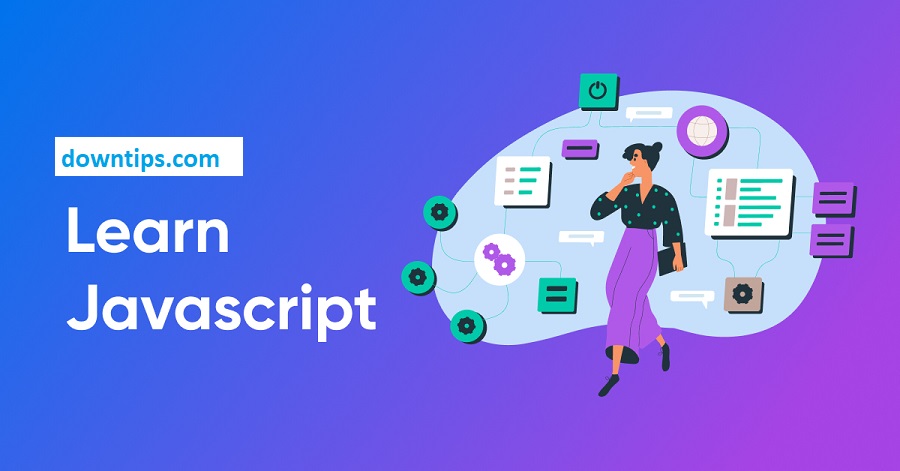Downtips gives you the best guide on How to learn JavaScript. Here are some instructions, guidance, and descriptions.
What is JavaScript?
JavaScript is a programming language commonly used for web development. It’s a versatile language that allows developers to create dynamic and interactive web pages. Here’s an overview of JavaScript:
- Client-Side Scripting: JavaScript is primarily a client-side scripting language, meaning it runs on the user’s web browser rather than on the web server. This allows JavaScript to interact with the content of a web page in real time, making web pages more dynamic and responsive.
- High-Level and Interpreted: JavaScript is a high-level language, which means it abstracts away low-level details like memory management and hardware interaction, making it easier to write and understand code. It’s also an interpreted language, meaning that JavaScript code is executed line by line by an interpreter built into the web browser.
- Dynamic and Weakly Typed: JavaScript is dynamically typed, meaning that variables can hold values of any data type without requiring explicit declaration. Additionally, JavaScript is weakly typed, meaning that data type conversions are performed implicitly, which can sometimes lead to unexpected behavior if not handled carefully.
- Versatile Language: JavaScript is not limited to web development; it can also be used for server-side development (Node.js), mobile app development (using frameworks like React Native), game development, desktop application development, and more. Its versatility and widespread adoption make it one of the most popular programming languages in the world.
- DOM Manipulation: One of the key features of JavaScript is its ability to manipulate the Document Object Model (DOM) of a web page. This allows developers to dynamically change the content, structure, and style of a web page in response to user actions or other events, such as clicks, scrolls, or form submissions.
- Event-Driven Programming: JavaScript is inherently event-driven, meaning that it responds to user interactions and system events by executing event handlers or callback functions. This allows developers to create interactive user interfaces and responsive web applications that react to user input in real-time.
- Extensive Ecosystem: JavaScript has a vast ecosystem of libraries, frameworks, and tools that extend its capabilities and simplify common tasks. Popular JavaScript libraries and frameworks include jQuery, React.js, AngularJS, Vue.js, and Express.js, among others.

How to learn JavaScript?
Learning JavaScript can be a rewarding journey, especially if you’re interested in web development or programming in general. Here’s a step-by-step guide to help you get started:
- Understand the Basics of Web Development: Before diving into JavaScript, it’s helpful to have a basic understanding of HTML (Hypertext Markup Language) and CSS (Cascading Style Sheets), which are the building blocks of web development. You can find numerous tutorials and resources online to learn HTML and CSS.
- Set Up Your Development Environment: To write and test JavaScript code, you’ll need a text editor and a web browser. Popular text editors for coding include Visual Studio Code, Sublime Text, and Atom. You can write JavaScript code directly in a text editor and then open an HTML file in a web browser to see the results.
- Start with the Fundamentals: Begin by learning the fundamental concepts of JavaScript, such as variables, data types, operators, control structures (if statements, loops), functions, and arrays. These basics form the foundation of JavaScript programming and are essential for understanding more advanced topics.
- Practice Regularly: Like any programming language, practice is crucial for learning JavaScript effectively. Try writing small scripts and experimenting with different features and functionalities. You can start with simple exercises and gradually work your way up to more complex projects.
- Explore the Document Object Model (DOM): JavaScript is commonly used to manipulate the Document Object Model (DOM) of a web page, which represents the structure and content of the page. Learn how to select elements, modify their properties, handle events, and create dynamic interactions using JavaScript and the DOM.
- Learn from Tutorials and Resources: There are countless tutorials, courses, and resources available online to learn JavaScript. Websites like MDN Web Docs, W3Schools, freeCodeCamp, and Codecademy offer comprehensive tutorials and interactive exercises for beginners and advanced learners alike.
- Build Projects: Building projects is one of the most effective ways to solidify your understanding of JavaScript and gain practical experience. Start with small projects like interactive web forms, simple games, or dynamic UI components, and gradually work your way up to larger projects as you become more confident.
- Join Online Communities: Join online communities and forums dedicated to JavaScript, such as Stack Overflow, Reddit’s r/learnjavascript, and various programming Discord servers. These communities are great places to ask questions, seek help, share knowledge, and connect with other learners and professionals.
- Explore Frameworks and Libraries: Once you’re comfortable with the basics of JavaScript, consider exploring popular JavaScript libraries and frameworks like jQuery, React.js, AngularJS, and Vue.js. These tools can help you build more sophisticated web applications and enhance your development skills.
- Stay Curious and Keep Learning: JavaScript is a vast and evolving language, so it’s important to stay curious and keep learning. Stay updated on new features, best practices, and industry trends by reading blogs, following experts on social media, and attending webinars and conferences.
Some Difficulties in JavaScript:
Learning JavaScript, like any programming language, can present challenges to beginners and experienced developers alike. Some common difficulties encountered when learning or working with JavaScript include:
- Asynchronous Programming: JavaScript is inherently asynchronous, meaning that certain operations, such as fetching data from a server or waiting for user input, may not execute sequentially. Understanding and mastering asynchronous programming concepts like callbacks, promises, and async/await can be challenging for beginners.
- Scope and Hoisting: JavaScript has function scope, which means variables declared inside a function are local to that function. Understanding variable scope and hoisting (the behavior where variable and function declarations are moved to the top of their containing scope during compilation) can be confusing for newcomers.
- Type Coercion and Equality: JavaScript is weakly typed, meaning that data type conversions are performed implicitly. This can lead to unexpected behavior when comparing values using loose equality operators (==) and strict equality operators (===), especially for beginners who may not fully understand how type coercion works.
- Prototype-based Inheritance: JavaScript uses prototype-based inheritance, rather than classical inheritance as in languages like Java or C++. Understanding prototype chains, constructor functions, and the prototype object can be challenging for developers accustomed to other programming paradigms.
- DOM Manipulation: While manipulating the Document Object Model (DOM) with JavaScript is powerful and versatile, it can also be complex and error-prone, especially when dealing with large or nested DOM structures. Managing event listeners, updating UI elements, and handling browser inconsistencies can pose challenges for developers.
- Browser Compatibility: JavaScript code may behave differently across different web browsers (such as Chrome, Firefox, Safari, and Edge), which can lead to cross-browser compatibility issues. Ensuring that JavaScript code works consistently across multiple browsers often requires testing and debugging.
- Memory Management: JavaScript manages memory automatically through garbage collection, but understanding how memory is allocated and deallocated can be important for optimizing performance, especially in memory-intensive applications.
- Error Handling and Debugging: Debugging JavaScript code can be challenging, especially for beginners. Learning how to use browser developer tools, console logging, breakpoints, and error-handling techniques is essential for identifying and fixing bugs effectively.
- Security Concerns: JavaScript code running on the client side is inherently less secure than server-side code, as it is accessible and modifiable by users. Understanding security best practices, such as avoiding client-side validation, preventing cross-site scripting (XSS) attacks, and sanitizing user input, is crucial for building secure web applications.
- Keeping Up with Updates and New Features: JavaScript is a rapidly evolving language, with new features, syntax enhancements, and libraries being introduced regularly. Staying updated on the latest developments and best practices can be challenging, but it’s essential for maintaining proficiency and leveraging the full power of JavaScript.
